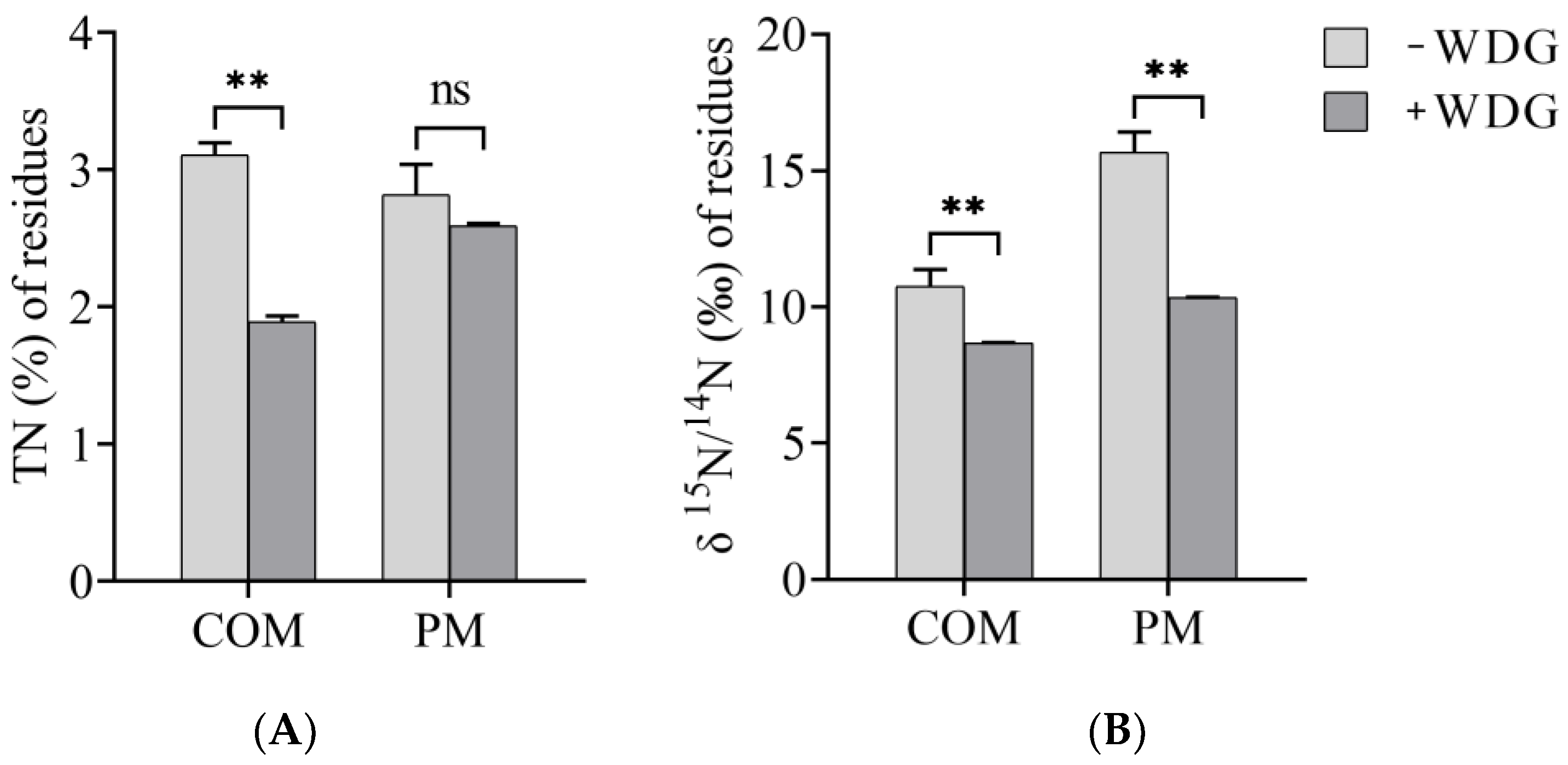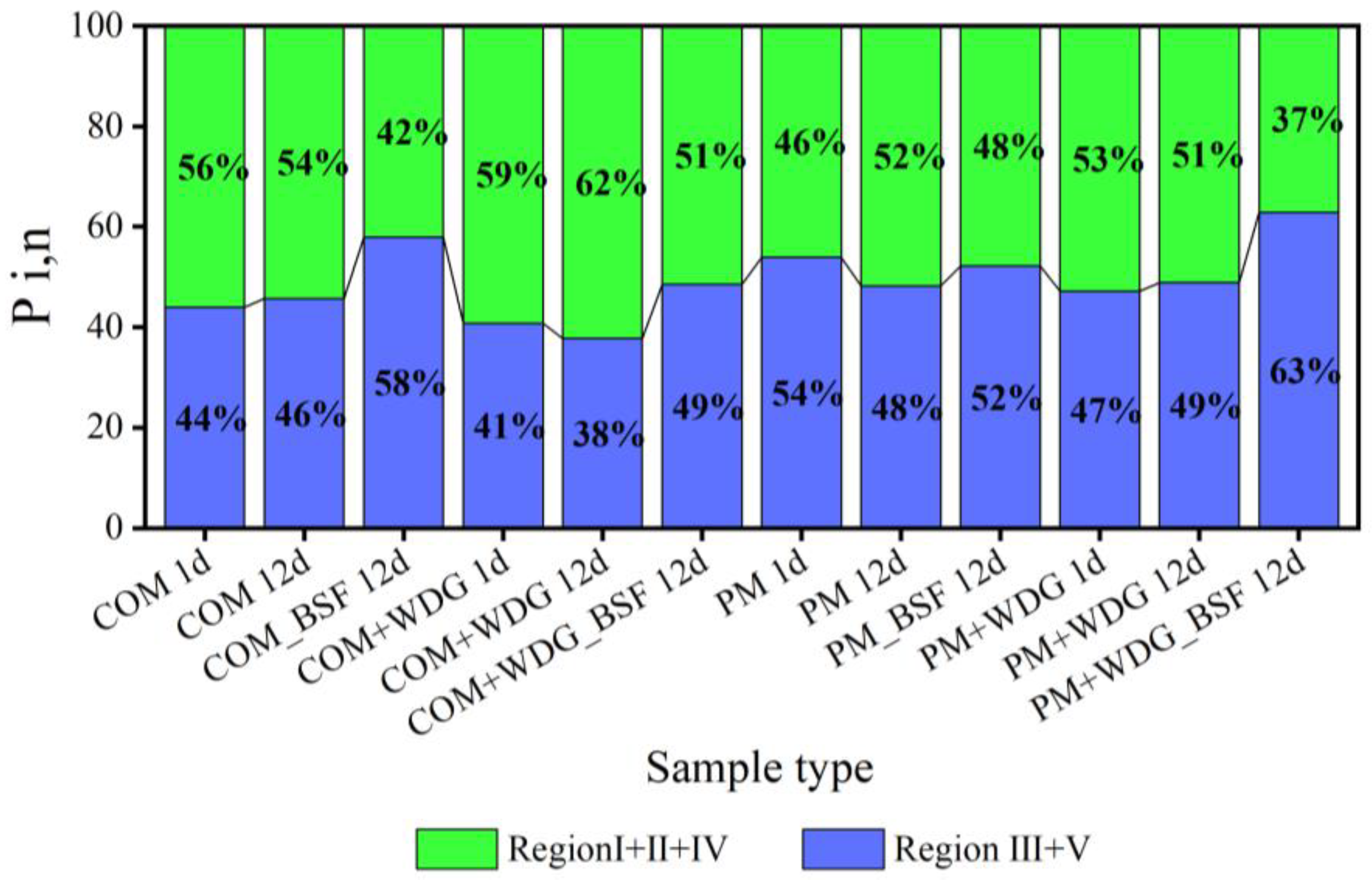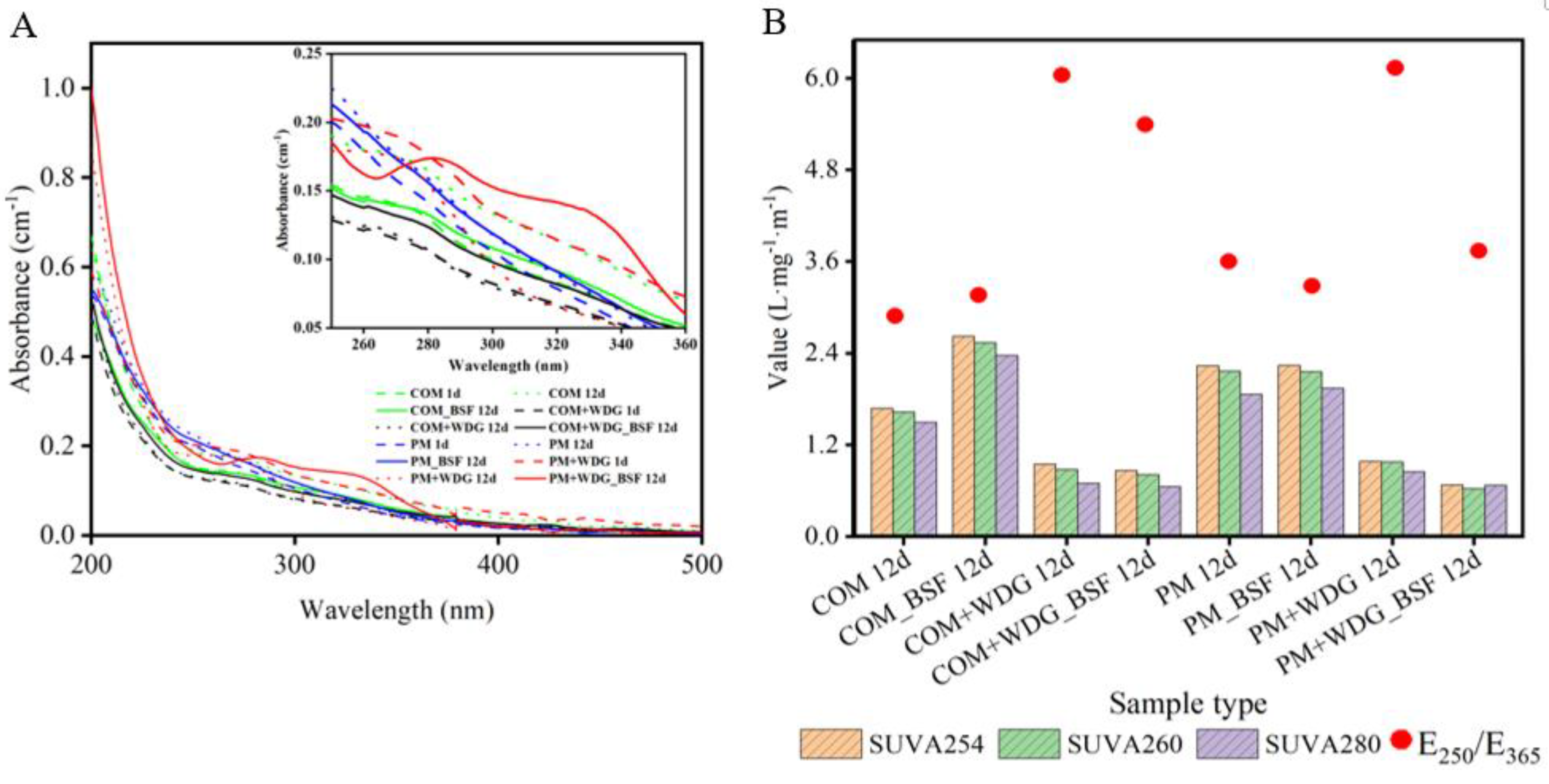Utilizing Black Soldier Fly Larvae to Improve Bioconversion and Reduce Pollution: A Sustainable Method for Efficient Treatment of Mixed Wastes of Wet Distiller Grains and Livestock Manure
Abstract
1. Introduction
2. Results
2.1. BSFL Treatment Efficiency for WDG-Added Livestock Manures
2.2. The Reduction in N-Relevant Harmful Gas Emission with the Addition of WDG in Livestock Manures Treated by BSFL
2.3. Effect of Adding WDG in Livestock Manures on the Organic Matter
2.3.1. EEM Spectra
2.3.2. UV–Vis Spectra
2.4. Phytotoxicity Study and Micronutrient Composition of Residues
3. Discussion
3.1. Enhancement in BSFL Bioconversion and Livestock Manures’ Reduction Rates
3.2. The Reduction in NH3 and N2O Emission
3.3. Identification of the Composition of Organic Matter
3.4. Non-Phytotoxicity and Rich Micronutrients of Residues
4. Materials and Methods
4.1. Raw Materials
4.2. Experimental Design
4.3. Survival and Growth of BSFLs on Livestock Manures
4.4. DOM Extraction and Spectral Analysis
4.5. Analysis of TP, TN, and δ15N/14N
4.6. Phytotoxicity Anlysis
4.7. Micronutrient Composition Anlysis
5. Data Analysis
6. Conclusions
Supplementary Materials
Author Contributions
Funding
Institutional Review Board Statement
Informed Consent Statement
Data Availability Statement
Conflicts of Interest
Availability of Data and Materials
Sample Availability
References
- Qian, Y.; Song, K.; Hu, T.; Ying, T. Environmental status of livestock and poultry sectors in China under current transformation stage. Sci. Total Environ. 2018, 622, 702–709. [Google Scholar] [CrossRef]
- Kaza, S.; Yao, L.; Bhada-Tata, P.; Van Woerden, F. What A Waste 2.0: A Global Snapshot of Solid Waste Management to 2050; World Bank Publications: Washington, DC, USA, 2018. [Google Scholar]
- Afazeli, H.; Jafari, A.; Rafiee, S.; Nosrati, M. An investigation of biogas production potential from livestock and slaughterhouse wastes. Renew. Sustain. Energy Rev. 2014, 34, 380–386. [Google Scholar] [CrossRef]
- Chen, X.; Zhao, Y.; Zeng, C.; Li, Y.; Zhu, L.; Wu, J.; Chen, J.; Wei, Z. Assessment contributions of physicochemical properties and bacterial community to mitigate the bioavailability of heavy metals during composting based on structural equation models. Bioresour. Technol. 2019, 289, 121657. [Google Scholar] [CrossRef]
- Gao, X.; Tan, W.; Zhao, Y.; Wu, J.; Sun, Q.; Qi, H.; Xie, X.; Wei, Z. Diversity in the mechanisms of humin formation during composting with different materials. Environ. Sci. Technol. 2019, 53, 3653–3662. [Google Scholar] [CrossRef] [PubMed]
- Galloway, J.N.; Dentener, F.J.; Capone, D.G.; Boyer, E.W.; Howarth, R.W.; Seitzinger, S.P.; Asner, G.P.; Cleveland, C.C.; Green, P.; Holland, E.A. Nitrogen cycles: Past, present, and future. Biogeochemistry 2004, 70, 153–226. [Google Scholar] [CrossRef]
- Oenema, O.; Wrage, N.; Velthof, G.L.; van Groenigen, J.W.; Dolfing, J.; Kuikman, P.J. Trends in global nitrous oxide emissions from animal production systems. Nutr. Cycl. Agroecosyst. 2005, 72, 51–65. [Google Scholar] [CrossRef]
- Klages, S.; Aue, C.; Reiter, K.; Heidecke, C.; Osterburg, B. Catch crops in lower saxony-more than 30 years of action against water pollution with nitrates: All in vain? Agriculture 2022, 12, 447. [Google Scholar] [CrossRef]
- Xiao, X.; Mazza, L.; Yu, Y.; Cai, M.; Zheng, L.; Tomberlin, J.K.; Yu, J.; van Huis, A.; Yu, Z.; Fasulo, S. Efficient co-conversion process of chicken manure into protein feed and organic fertilizer by Hermetia illucens L. (diptera: Stratiomyidae) larvae and functional bacteria. J. Environ. Manag. 2018, 217, 668–676. [Google Scholar] [CrossRef]
- Kim, C.-H.; Ryu, J.; Lee, J.; Ko, K.; Lee, J.-Y.; Park, K.Y.; Chung, H. Use of black soldier fly larvae for food waste treatment and energy production in asian countries: A review. Processes 2021, 9, 161. [Google Scholar] [CrossRef]
- Parodi, A.; Yao, Q.; Gerrits, W.J.; Mishyna, M.; Lakemond, C.M.; Oonincx, D.G.; Van Loon, J.J. Upgrading ammonia-nitrogen from manure into body proteins in black soldier fly larvae. Resour. Conserv. Recycl. 2022, 182, 106343. [Google Scholar] [CrossRef]
- Wang, Q.; Ren, X.; Sun, Y.; Zhao, J.; Awasthi, M.K.; Liu, T.; Li, R.; Zhang, Z. Improvement of the composition and humification of different animal manures by black soldier fly bioconversion. J. Clean. Prod. 2021, 278, 123397. [Google Scholar] [CrossRef]
- Bohm, K.; Hatley, G.A.; Robinson, B.H.; Gutiérrez-Ginés, M.J. Black soldier fly-based bioconversion of biosolids creates high-value products with low heavy metal concentrations. Resour. Conserv. Recycl. 2022, 180, 106149. [Google Scholar] [CrossRef]
- Liu, T.; Awasthi, M.K.; Wang, X.; Awasthi, S.K.; Jiao, M.; Shivpal, V.; Zhou, Y.; Liu, H.; Zhang, Z. Effects of further composting black soldier fly larvae manure on toxic metals and resistant bacteria communities by cornstalk amendment. Sci. Total Environ. 2022, 806, 150699. [Google Scholar] [CrossRef]
- Li, Q.; Zheng, L.; Qiu, N.; Cai, H.; Tomberlin, J.K.; Yu, Z. Bioconversion of dairy manure by black soldier fly (Diptera: Stratiomyidae) for biodiesel and sugar production. Waste Manag. 2011, 31, 1316–1320. [Google Scholar] [CrossRef] [PubMed]
- He, X.S.; Xi, B.; Li, X.; Pan, H.W.; An, D.; Bai, S.G.; Li, D.; Cui, D.Y. Fluorescence excitation-emission matrix spectra coupled with parallel factor and regional integration analysis to characterize organic matter humification. Chemosphere 2013, 93, 2208–2215. [Google Scholar] [CrossRef] [PubMed]
- Xi, B.D.; He, X.S.; Wei, Z.M.; Jiang, Y.H.; Li, M.X.; Li, D.; Li, Y.; Dang, Q.L. Effect of inoculation methods on the composting efficiency of municipal solid wastes. Chemosphere 2012, 88, 744–750. [Google Scholar] [CrossRef]
- Elhag, O.; Zhou, D.; Song, Q.; Soomro, A.A.; Cai, M.; Zheng, L.; Yu, Z.; Zhang, J. Screening, expression, purification and functional characterization of novel antimicrobial peptide genes from Hermetia illucens (L.). PLoS ONE 2017, 12, e0169582. [Google Scholar] [CrossRef]
- Mwaniki, Z.; Shoveller, A.K.; Huber, L.A.; Kiarie, E.G. Complete replacement of soybean meal with defatted black soldier fly larvae meal in Shaver White hens feeding program (28–43 wks of age): Impact on egg production, egg quality, organ weight, and apparent retention of components. Poult. Sci. 2020, 99, 959–965. [Google Scholar] [CrossRef]
- China Feed Industry Information Network. Prices of Imported and Domestically Produced Fish Meal in China in February; China Feed Industry Information Network: Beijing, China, 2023. [Google Scholar]
- Wang, C.; Guo, X.; Deng, H.; Dong, D.; Tu, Q.; Wu, W. New insights into the structure and dynamics of actinomycetal community during manure composting. Appl. Microbiol. Biotechnol. 2014, 98, 3327–3337. [Google Scholar] [CrossRef] [PubMed]
- Gold, M.; Cassar, C.M.; Zurbrügg, C.; Kreuzer, M.; Boulos, S.; Diener, S.; Mathys, A. Biowaste treatment with black soldier fly larvae: Increasing performance through the formulation of biowastes based on protein and carbohydrates. Waste Manag. 2020, 102, 319–329. [Google Scholar] [CrossRef]
- Gao, M.; Liang, F.; Yu, A.; Li, B.; Yang, L. Evaluation of stability and maturity during forced-aeration composting of chicken manure and sawdust at different c/n ratios. Chemosphere 2010, 78, 614–619. [Google Scholar] [CrossRef] [PubMed]
- Lalander, C.; Diener, S.; Zurbrügg, C.; Vinnerås, B. Effects of feedstock on larval development and process efficiency in waste treatment with black soldier fly (Hermetia illucens). J. Clean. Prod. 2019, 208, 211–219. [Google Scholar] [CrossRef]
- Imai, A.; Fukushima, T.; Matsushige, K.; Kim, Y.H. Fractionation and characterization of dissolved organic matter in a shallow eutrophic lake, its inflowing rivers, and other organic matter sources. Water Res. 2001, 35, 4019–4028. [Google Scholar] [CrossRef]
- Zhang, F.; Wang, Y.; Chu, Y.; Gao, B.; Yue, Q.; Yang, Z.; Li, Q. Reduction of organic matter and trihalomethane formation potential in reclaimed water from treated municipal wastewater by coagulation and adsorption. Chem. Eng. J. 2013, 223, 696–703. [Google Scholar] [CrossRef]
- Strokal, M.; Kroeze, C.; Wang, M.; Bai, Z.; Ma, L. The marina model (model to assess river inputs of nutrients to seas): Model description and results for China. Sci. Total Environ. 2016, 562, 869–888. [Google Scholar] [CrossRef] [PubMed]
- Chen, W.; Westerhoff, P.; Leenheer, J.A.; Booksh, K. Fluorescence excitation-emission matrix regional integration to quantify spectra for dissolved organic matter. Environ. Sci. Technol. 2003, 37, 5701–5710. [Google Scholar] [CrossRef] [PubMed]
- Chin, Y.-P.; Aiken, G.R.; Danielsen, K.M. Binding of pyrene to aquatic and commercial humic substances: The role of molecular weight and aromaticity. Environ. Sci. Technol. 1997, 31, 1630–1635. [Google Scholar] [CrossRef]
- Peuravuori, J.; Pihlaja, K. Molecular size distribution and spectroscopic properties of aquatic humic substances. Anal. Chim. Acta 1997, 337, 133–149. [Google Scholar] [CrossRef]
- Nishijima, W.; Speitel, G.E., Jr. Fate of biodegradable dissolved organic carbon produced by ozonation on biological activated carbon. Chemosphere 2004, 56, 113–119. [Google Scholar] [CrossRef]
- Zhang, X.; Li, Y.; Ye, J.; Chen, Z.; Ren, D.; Zhang, S. The spectral characteristics and cadmium complexation of soil dissolved organic matter in a wide range of forest lands. Environ. Pollut. 2022, 299, 118834. [Google Scholar] [CrossRef]
- Song, C.; Li, M.; Xi, B.; Wei, Z.; Zhao, Y.; Jia, X.; Qi, H.; Zhu, C. Characterisation of dissolved organic matter extracted from the bio-oxidative phase of co-composting of biogas residues and livestock manure using spectroscopic techniques. Int. Biodeterior. Biodegrad. 2015, 103, 38–50. [Google Scholar] [CrossRef]
- Ma, J.J.; Jiang, C.L.; Tao, X.H.; Sheng, J.L.; Sun, X.Z.; Zhang, T.Z.; Zhang, Z.J. Insights on dissolved organic matter and bacterial community succession during secondary composting in residue after black soldier fly larvae (Hermetia illucens L.) bioconversion for food waste treatment. Waste Manag. 2022, 142, 55–64. [Google Scholar] [CrossRef]
- Murphy, K.R.; Hambly, A.; Singh, S.; Henderson, R.K.; Baker, A.; Stuetz, R.; Khan, S.J. Organic matter fluorescence in municipal water recycling schemes: Toward a unified parafac model. Environ. Sci. Technol. 2011, 45, 2909–2916. [Google Scholar] [CrossRef] [PubMed]
- Parodi, A.; Gerrits, W.J.; Van Loon, J.J.; De Boer, I.J.; Aarnink, A.J.; Van Zanten, H.H. Black soldier fly reared on pig manure: Bioconversion efficiencies, nutrients in the residual material, greenhouse gas and ammonia emissions. Waste Manag. 2021, 126, 674–683. [Google Scholar] [CrossRef] [PubMed]
- Chadwick, D.; Wei, J.; Yan’an, T.; Guanghui, Y.; Qirong, S.; Qing, C. Improving manure nutrient management towards sustainable agricultural intensification in china. Agric. Ecosyst. Environ. 2015, 209, 34–46. [Google Scholar] [CrossRef]
- Rehman, K.U.; Hollah, C.; Wiesotzki, K.; Rehman, R.U.; Rehman, A.U.; Zhang, J.; Zheng, L.; Nienaber, T.; Heinz, V.; Aganovic, K. Black soldier fly, Hermetia illucens as a potential innovative and environmentally friendly tool for organic waste management: A mini-review. Waste Manag. Res. 2023, 41, 81–97. [Google Scholar] [CrossRef]
- Lim, J.W.; Mohd-Noor, S.N.; Wong, C.Y.; Lam, M.K.; Goh, P.S.; Beniers, J.; Oh, W.D.; Jumbri, K.; Ghani, N.A. Palatability of black soldier fly larvae in valorizing mixed waste coconut endosperm and soybean curd residue into larval lipid and protein sources. J. Environ. Manag. 2019, 231, 129–136. [Google Scholar] [CrossRef]
- Hao, J.; Liu, S.; Luo, A.; Zhao, J.; Shi, S.; Zhang, Y.; Li, C. Assessing nursery-finishing pig manures on growth of black soldier fly larvae. Animals 2023, 13, 452. [Google Scholar] [CrossRef]
- De Souza Vilela, J.; Alvarenga, T.I.R.C.; Andrew, N.R. Technological quality, amino acid and fatty acid profile of broiler meat enhanced by dietary inclusion of black soldier fly larvae. Foods 2021, 10, 297. [Google Scholar] [CrossRef]
- Seyedalmoosavi, M.M.; Dannenberger, D.; Pfuhl, R. Lipid metabolism, fatty acid composition and meat quality in broilers supplemented with increasing levels of defrosted black soldier fly larvae. J. Insects Food Feed 2023, 9, 583–598. [Google Scholar] [CrossRef]
- Shi, Z.H.; Zhang, J.; Jiang, Y.J.; Wen, Y.T.; Gao, Z.H.; Deng, W.H.; Yin, Y.M.; Zhu, F. Two low-toxic Klebsiella pneumoniae strains from gut of black soldier fly Hermetia illucens are multi-resistance to sulfonamides and cadmium. Environ. Pollut. 2022, 312, 120062. [Google Scholar] [CrossRef] [PubMed]
- Deng, B.; Zhu, J.; Wang, G.; Xu, C.; Zhang, X.; Wang, P.; Yuan, Q. Effects of three major nutrient contents, compost thickness and treatment time on larval weight, process performance and residue component in black soldier fly larvae (Hermetia illucens) composting. J. Environ. Manag. 2022, 307, 114610. [Google Scholar] [CrossRef] [PubMed]
- Gerber, P.J.; Steinfeld, H.; Henderson, B.; Mottet, A.; Opio, C.; Dijkman, J.; Falcucci, A.; Tempio, G. Tackling Climate Change through Livestock: A Global Assessment of Emissions and Mitigation Opportunities; Food and Agriculture Organization: Rome, Italy, 2013. [Google Scholar]
- Parodi, A.; De Boer, I.J.; Gerrits, W.J.; Van Loon, J.J.; Heetkamp, M.J.; Van Schelt, J.; Bolhuis, J.E.; Van Zanten, H.H. Bioconversion efficiencies, greenhouse gas and ammonia emissions during black soldier fly rearing—A mass balance approach. J. Clean. Prod. 2020, 271, 122488. [Google Scholar] [CrossRef]
- Hou, Y.; Velthof, G.L.; Lesschen, J.P.; Staritsky, I.G.; Oenema, O. Nutrient recovery and emissions of ammonia, nitrous oxide, and methane from animal manure in Europe: Effects of manure treatment technologies. Environ. Sci. Technol. 2017, 51, 375–383. [Google Scholar] [CrossRef] [PubMed]
- Baker, A. Fluorescence excitation-emission matrix characterization of some sewage-impacted rivers. Environ. Sci. Technol. 2001, 35, 948–953. [Google Scholar] [CrossRef] [PubMed]
- Ahmad, S.; Reynolds, D. Monitoring of water quality using fluorescence technique: Prospect of on-line process control. Water Res. 1999, 33, 2069–2074. [Google Scholar] [CrossRef]
- Coble, P.G.; Green, S.A.; Blough, N.V.; Gagosian, R.B. Characterization of dissolved organic matter in the black sea by fluorescence spectroscopy. Nature 1990, 348, 432–435. [Google Scholar] [CrossRef]
- He, X.S.; Xi, B.D.; Jiang, Y.H.; Li, M.X.; Yu, H.B.; An, D.; Yang, Y.; Liu, H.L. Elemental and spectroscopic methods with chemometric analysis for characterizing composition and transformation of dissolved organic matter during chicken manure composting. Environ. Technol. 2012, 33, 2033–2039. [Google Scholar] [CrossRef]
- Bhadra, R.; Muthukumarappan, K.; Rosentrater, K. Physical and chemical characterization of fuel ethanol coproducts relevant to value-added uses. Cereal Chem. 2010, 87, 439–447. [Google Scholar] [CrossRef]
- Yang, Y.; Wang, G.Y.; Li, G.X.; Ma, R.N.; Kong, Y.L.; Yuan, J. Selection of sensitive seeds for evaluation of compost maturity with the seed germination index. Waste Manag. 2021, 136, 238–243. [Google Scholar] [CrossRef]
- Wang, D.M.; Wu, D.; Li, J.; Zhang, L.L. Effects of water extraction ratio of pig manure and its compost on seed germinative indicators. J. Agro Environ. Sci. 2011, 30, 579–584. [Google Scholar]
- Wang, G.; Kong, Y.; Liu, Y.; Li, D.; Zhang, X.; Yuan, J.; Li, G. Evolution of phytotoxicity during the active phase of co-composting of chicken manure, tobacco powder and mushroom substrate. Waste Manag. 2020, 114, 25–32. [Google Scholar] [CrossRef] [PubMed]
- Liu, Y.; Feng, J.; Wang, Y.; Lv, J.; Li, J.; Guo, L.; Min, Y. Fermented corn-soybean meal mixed feed modulates intestinal morphology, barrier functions and cecal microbiota in laying hens. Animals 2021, 11, 3059. [Google Scholar] [CrossRef] [PubMed]
- Diener, S.; Zurbrügg, C.; Tockner, K. Conversion of organic material by black soldier fly larvae: Establishing optimal feeding rates. Waste Manag. Res. 2009, 27, 603–610. [Google Scholar] [CrossRef] [PubMed]
- Gigliotti, G.; Kaiser, K.; Guggenberger, G.; Haumaier, L. Differences in the chemical composition of dissolved organic matter from waste material of different sources. Biol. Fertil. Soils 2002, 36, 321–329. [Google Scholar] [CrossRef]
- He, X.S.; Xi, B.D.; Jiang, Y.H.; He, L.S.; Li, D.; Pan, H.W.; Bai, S.G. Structural transformation study of water-extractable organic matter during the industrial composting of cattle manure. Microchem. J. 2013, 106, 160–166. [Google Scholar] [CrossRef]
- Komatsu, K.; Onodera, T.; Kohzu, A.; Syutsubo, K.; Imai, A. Characterization of dissolved organic matter in wastewater during aerobic, anaerobic, and anoxic treatment processes by molecular size and fluorescence analyses. Water Res. 2020, 171, 115459. [Google Scholar] [CrossRef]
- Wang, Q.; Awasthi, M.K.; Zhao, J.; Ren, X.; Wang, M.; Li, R.; Wang, Z.; Zhang, Z. Utilization of medical stone to improve the composition and quality of dissolved organic matter in composted pig manure. J. Clean. Prod. 2018, 197, 472–478. [Google Scholar] [CrossRef]
- Ministry of Ecology and Environment of the People’s Republic of China. Soil and Sediment-Determination of Aqua Regia Extracts of 12 Metal Elements-Inductively Coupled Plasma Mass Spectrometry; China Environmental Press: Beijing, China, 2016. [Google Scholar]




| Treatment | Sample Rate | Total Weight (Dry Weight) | Survival Rate (%) | Growth Rate Index (mg/Days) | Substrate Reduction Rate (%) | Bioconversion Rate (%) |
|---|---|---|---|---|---|---|
| COM | 100%COM | 150 g | 65.42 ± 0.29 a | 0.27 ± 0.03 b | 43.85 ± 0.74 a | 1.20 ± 0.02 b |
| COM + WDG | 55%COM + 45%WDG | 89.08 ± 0.14 c | 1.22 ± 0.02 c | 73.41 ± 2.12 c | 10.54 ± 0.06 c | |
| PM | 100%PM | 66.58 ± 0.14 b | 0.16 ± 0.01 a | 42.70 ± 2.43 a | 0.92 ± 0.02 a | |
| PM + WDG | 55%PM + 45%WDG | 94.00 ± 0.25 d | 1.11 ± 0.06 d | 67.11 ± 2.52 b | 10.05 ± 0.11 d |
Disclaimer/Publisher’s Note: The statements, opinions and data contained in all publications are solely those of the individual author(s) and contributor(s) and not of MDPI and/or the editor(s). MDPI and/or the editor(s) disclaim responsibility for any injury to people or property resulting from any ideas, methods, instructions or products referred to in the content. |
© 2023 by the authors. Licensee MDPI, Basel, Switzerland. This article is an open access article distributed under the terms and conditions of the Creative Commons Attribution (CC BY) license (https://creativecommons.org/licenses/by/4.0/).
Share and Cite
Li, T.; Khan, S.; Wei, M.; Li, H.; Wen, T.; Guo, J.; Jin, D. Utilizing Black Soldier Fly Larvae to Improve Bioconversion and Reduce Pollution: A Sustainable Method for Efficient Treatment of Mixed Wastes of Wet Distiller Grains and Livestock Manure. Molecules 2023, 28, 5735. https://doi.org/10.3390/molecules28155735
Li T, Khan S, Wei M, Li H, Wen T, Guo J, Jin D. Utilizing Black Soldier Fly Larvae to Improve Bioconversion and Reduce Pollution: A Sustainable Method for Efficient Treatment of Mixed Wastes of Wet Distiller Grains and Livestock Manure. Molecules. 2023; 28(15):5735. https://doi.org/10.3390/molecules28155735
Chicago/Turabian StyleLi, Tao, Samiullah Khan, Mao Wei, Haiyin Li, Tingchi Wen, Jianjun Guo, and Daochao Jin. 2023. "Utilizing Black Soldier Fly Larvae to Improve Bioconversion and Reduce Pollution: A Sustainable Method for Efficient Treatment of Mixed Wastes of Wet Distiller Grains and Livestock Manure" Molecules 28, no. 15: 5735. https://doi.org/10.3390/molecules28155735
APA StyleLi, T., Khan, S., Wei, M., Li, H., Wen, T., Guo, J., & Jin, D. (2023). Utilizing Black Soldier Fly Larvae to Improve Bioconversion and Reduce Pollution: A Sustainable Method for Efficient Treatment of Mixed Wastes of Wet Distiller Grains and Livestock Manure. Molecules, 28(15), 5735. https://doi.org/10.3390/molecules28155735








